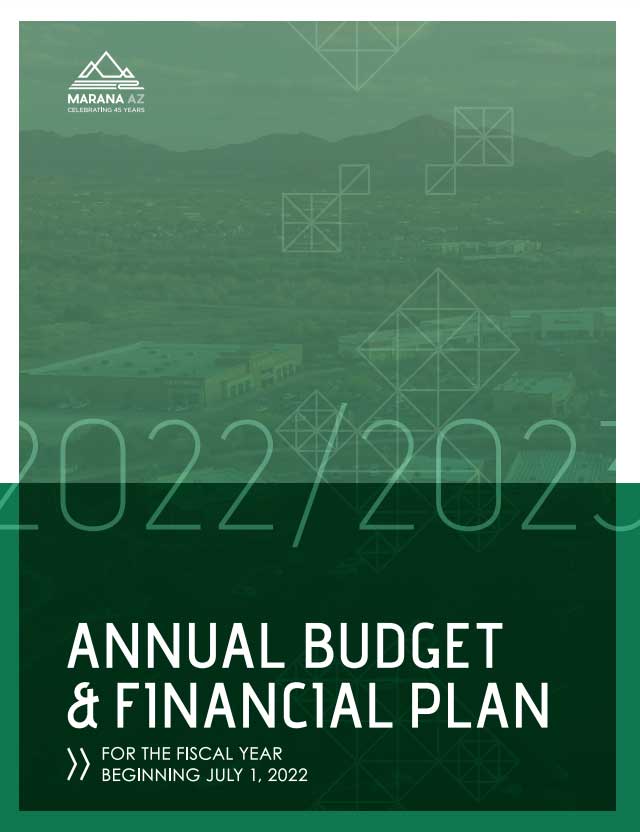The Town of Marana, located in Pima County, Arizona, faces several infrastructure challenges. One of the primary challenges is maintaining the town’s water supply in the face of drought and other environmental factors. The town has also struggled with providing adequate transportation infrastructure to accommodate its growing population, particularly in terms of expanding roads and highways to relieve congestion. In addition, Marana has experienced rapid development in recent years, which has put a strain on its existing infrastructure and resources, particularly in terms of utilities and public services.

Sample Highlights from the Capital Improvement Plan
Project ID
Project Title
Project Start Year
Project Description
Project Spend Total
Page Ref
Project Satus
618546
Runway 3-21, Taxiway B2 Reconstruction, Hangar 6 Removal
2025
“The project will design and construct the reconstruction of Runway 3-21,
relocation of Taxiway B2 and the removal of Hangar 6. The runway pavement
require reconstruction. Taxiway B2 relocation will remove direct access from
the center apron and runway 3-21. Hangar 6 is considered a penetration to
the Taxiway ‘B’ Taxiway Object Free Area TOFA and require removal.”
7128000
146
Not Started
618550
Taxiways B and E Lighting Upgrade
2026
“The lighting systems for Taxiway B and E are beyond their useful life and require
replacement. This project will replace lighting and signage fixtures, along with
airfield lighting cable. The two lighting systems will be upgraded to LED fixtures.”
1650000
146
Not Started
618561
B-Zone Booster and Transmission Line
2025
“This project will continue to provide water supply and fire flow capacity north along
the Twin Peaks Corridor for new development.”
4413000
148
Not Started
618596
Hartman Booster Station Electrical Upgrade
2024
“Planning, design, and construction of electrical modifications required to install
new auto transfer switches and generators. Generator must be sufficient to
provide power for the booster site, including SCADA system.”
220000
150
Not Started
618649
Tangerine 16-Inch with Break Tanks
2025
“This project entails parcel qcquisitions, installing 16,750 linear feet of water main
and two 50,000 break tanks. This is required to help complete the Loop from the
Twin Peaks Corridor and into North Marana, and will help provide adequate water
supply and fire flow capacity to this region.”
661000
156
Not Started
Explore all options available to you!
Citylitics offers access to over 30,000 unique locations across North America through our Capital Projects Dashboard (CPD).
Capital Projects Dashboard (CPD) provides a comprehensive market view of all planned infrastructure spend in one single view with powerful filters such as: population, project value, fiscal year, project status, project description, geography, and more. The dashboard will help identify opportunity hot spots, create data-driven forecasts you can be confident in with bottom-up data for the next 5 years of planned infrastructure spend, and uncover true market needs.
How to Read a Capital Improvement Plan (CIP) for Business Development?
When a city, municipality or state issues a Capital Improvement Plan (CIP), it can be overwhelming and daunting, but there are a few key things you need to investigate. Let’s start with the definition of CIP – A Capital Improvement Plan (CIP) contains all the individual capital projects, equipment purchases, and major studies for a local government; in conjunction with construction and completion schedules, and in consort with financing plans. The plan provides a working blueprint for sustaining and improving the community’s infrastructures. It coordinates strategic planning, financial capacity, and physical development. A CIP stands at the epicenter of a government’s Planning, Public Works, and Finance departments. When a CIP is issued, it typically includes the following information:
- A listing of the capital projects or equipment to be purchased
- The projects ranked in order of preference
- The plan for financing the projects
- A timetable for the construction or completion of the project
- Justification for the project
- Explanation of expenses for the project
Now, for business development, while the capital plan is interesting, the capital program is for capital expenditures that extends five to ten years beyond the capital budget. Knowing the difference is important so you can influence upcoming program versus just responding to an RFP. If reading the CIP makes your head explode, or you want to save time, Request a Demo of Citylitics CIP dashboard with over 20,000 CIPs from USA and Canada. Citylitics has 20,000 plus available CIPs, how can we help you? What states, cities or counties are you looking to improvement your business development, we can assist you in influencing an upcoming RFP versus simply responding to an RFP. Citylitics Capital Projects Dataset is a comprehensive resource for businesses and organizations looking to track and analyze planned infrastructure spend in their area. The dataset offers a range of features and benefits, including:
- Comprehensive Market View: The dataset provides a single view of all planned infrastructure spend, with powerful filters such as population, project value, fiscal year, project status, project description, geography, and more. This allows businesses to gain a comprehensive understanding of the market and identify new opportunities.
- Identify Opportunity Hot Spots: The dataset offers map views and filters that allow users to identify opportunity hot spots where they need to allocate resources. This helps businesses to understand where they should focus their efforts to achieve the best results.
- Create Data-Driven Forecasts: The dataset provides bottom-up data for the next 5 years of planned infrastructure spend, allowing businesses to create data-driven forecasts they can be confident in.
- Uncover True Market Needs: The dataset allows businesses to develop long-term business plans, R&D, and growth initiatives based on true, bottom-up market needs instead of opinions and anecdotes. This helps businesses to make more informed decisions and achieve better results.
With Citylitics Capital Projects Dataset, businesses can gain a deeper understanding of planned infrastructure spend in their area, which can help them to identify new opportunities and make more informed decisions.
